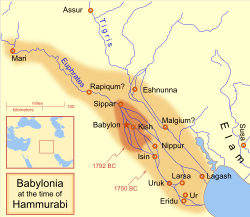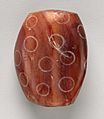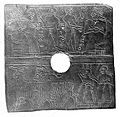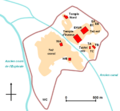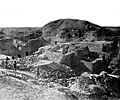Nippur facts for kids
Nippur was an ancient city in Sumer, which is now modern Nuffar in Iraq. It was one of the oldest cities in the world. Nippur was very important because it was the main place to worship the Sumerian god, Enlil. Enlil was known as the "lord wind" and was believed to rule the entire universe. He was only below the god An.
Nippur was always part of a larger empire. Controlling Nippur was a big deal because it showed that a ruler had overall "kingship" over other city-states. It was a sacred city, meaning it was considered holy. This was because it held the famous shrine of Enlil.
Contents
Nippur's Early Rulers
Late in the 3rd millennium BC, Nippur was taken over by the Semitic rulers from Akkad. Famous rulers like Sargon left gifts at Enlil's temple. Another ruler, Naram-Suen, rebuilt the temple and the city walls. His remains were even found there! After the Akkadians, the city was controlled by the third dynasty of Ur. Great builders like Ur-Nammu built new structures on top of Naram's old ones.
Nippur Through the Ages
The Kassite Period
Around the middle of the 2nd millennium BC, the Kassite rulers brought Nippur back to its former glory. The city became important and beautiful once more.
Decline and Revival
After the 12th century BC, Nippur was mostly forgotten for a long time. But it came back to life when the Assyrian ruler Sargon II conquered Babylonia in the late 8th century BC. Under Ashurbanipal, around the mid-7th century BC, the main temple, Ekur, was rebuilt. It was grander than ever, with a huge ziggurat (a stepped pyramid-like temple tower) that measured 58 by 39 meters.
Later History
After this grand period, Nippur slowly started to decay. By the Seleucid period, the ancient temple was turned into a fortress. Large walls were built, and houses and streets filled the temple courts. People lived in this fortress until about AD 250, during the Parthian period.
Under the Sassanid rulers, Nippur continued to decline. The old holy place became just a small village with mud huts around the ancient ziggurat. Even so, Nippur was still home to a Christian diocese (a church district) until the 8th century AD.
Exploring Ancient Nippur
Where is Nippur?
Nippur was built on both sides of the Shatt-en-Nil canal. This canal was one of the earliest paths of the Euphrates River. The city lies between the Euphrates and the Tigris rivers, about 160 kilometers southeast of Baghdad. The dry bed of the old Shatt-en-Nil divides the ruins into two main parts. The highest point, a conical hill about 30 meters tall, is called Bint el-Amiror by the local Arabs. This means 'prince's daughter'.
Digging Up the Past
Nippur was first briefly dug up by Sir Austen Henry Layard in 1851. Later, a full-scale excavation began with an expedition from the University of Pennsylvania. They worked for four seasons between 1889 and 1900. More recently, Nippur was excavated for 19 seasons between 1948 and 1990. These digs helped us learn a lot about this ancient city.
Images for kids
-
Indus Civilisation carnelian bead with white design, ca. 2900–2350 BC. Found in Nippur. This shows early connections between the Indus Valley and Mesopotamia.
-
The vase of Lugalzagesi, found in Nippur.
-
A Babylonian cuneiform tablet with a map from Nippur, from the Kassite period, 1550–1450 BC.
See also
 In Spanish: Nippur para niños
In Spanish: Nippur para niños


